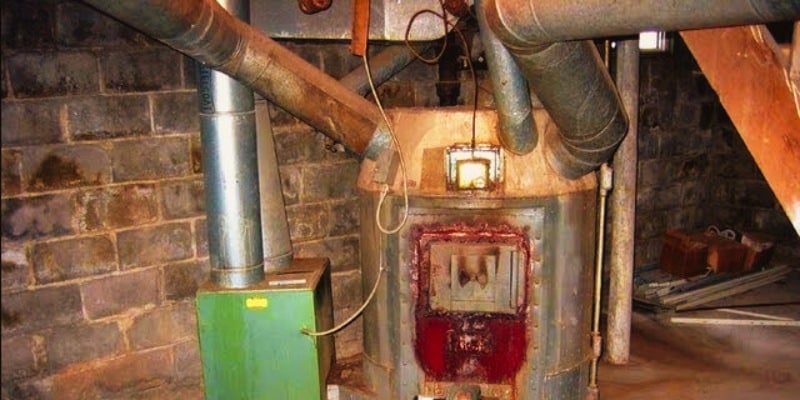If you’ve ever stumbled upon this giant metal octopus with its arms stretching out into various parts of your home, then you’ve encountered a gravity furnace. But here’s the catch: if you live in a newer or recently modernized home, there’s a good chance you’ve never heard of, let alone seen, gravity furnaces before.
This type of furnace, a relic from the past, was all the rage in the late nineteenth century, and its popularity didn’t wane until the mid-twentieth century. They were the unsung heroes in commercial and residential settings, keeping everyone warm without today’s modern HVAC systems. However, wander into older homes and buildings across the US, and you might just spot one of these vintage gravity heating systems still standing tall.
Yes, many of these gravity furnace systems are still around, a testament to the durability and lasting legacy of a bygone era! So, let’s delve into the world of gravity furnaces, exploring their workings, safety, and whether these historical pieces can still compete with their modern-day counterparts.
What Is a Gravity Furnace?
Now, you’re probably wondering, “What on earth is a gravity furnace?” Let’s unravel the mystery of this old-time heating marvel.
Gravity furnaces or octopus furnaces are so-called because they harness a fundamental principle of physics. They depend on hot air’s natural buoyancy or ability to defy gravity (i.e., rise), spreading warmth from the basement to every nook and cranny above.

Picture this antique system, typically in the basement, like a benevolent metal octopus. Each tentacle, or duct, stretches from the furnace, penetrating through floors to deliver heat directly to every room in the house. That’s right; every room enjoys its direct link to the warmth, which is how our friend earned its “octopus furnace” moniker.
But what kept this octopus kicking? Well, initially, these furnaces feasted on coal. However, as times changed, so did their diet. Many were converted to oil-burning units in the 1950s, while others adapted to munch on propane or natural gas.
And here’s the kicker – these systems were built to last. With no electrical or mechanical parts, gravity furnaces have weathered decades, steadfastly standing their ground. They operate in silence, their lack of a blower ensuring the quiet delivery of a slow and steady stream of heat.
Sure, gravity furnaces have their perks, but they hail from an era long gone. Heating technology has taken leaps and bounds since these iron giants were in vogue, and, if we’re being honest, time hasn’t favored our good old gravity furnaces. They’re now tethered with a laundry list of drawbacks in efficiency, space, and overall performance compared to modern heating systems.
How Gravity Furnace Works?
How does this ancient relic work? The furnace heats the air, which, being a show-off, naturally rises through the ducts and saunters into your rooms above.
These aren’t your average ducts; there are no modern blower fans here. Instead, these systems bank on nature’s physics, allowing warm air to rise naturally, filling each room with a quiet, gentle heat that modern forced-air systems often lack.
But it’s not all quiet coziness. Gravity furnaces come with a catch — they’re not the heroes of efficiency.
A shocking 50% of the heat they generate goes on an unfortunate journey straight up the chimney, lost to the winds. This means they guzzle up fuel, needing almost double the oil or gas that their modern, more efficient counterparts do. They’re slow coaches, too, taking their time to warm spaces, a stark contrast to the quick comfort delivered by contemporary systems.
Despite their shortcomings, gravity furnaces have a quaint charm. They run without the buzz and whir of today’s systems, don’t circulate dust, and speak of a simpler time. But in an age where efficiency and speed are kings, they’re the gentle giants that time forgot, still humming along in houses that remember the old ways.
Are Gravity Furnaces Safe?
Good news first – yes, gravity furnaces can be safe. When given the TLC they deserve, these historical relics are on par with their modern descendants regarding safety.
But here’s a wrinkle in time for you: asbestos!
That’s right, many of these old-timers house asbestos within their aging structures. When left alone, asbestos is like that ghost in the attic – you don’t bother each other. But if the system gets damaged and the asbestos is disturbed or exposed, we’re talking serious health jeopardy. It’s like waking that ghost, and suddenly, your house isn’t so safe anymore.
This health gamble is a significant reason many folks have decided to say goodbye to their antique heating systems. It’s not just about upgrading to more efficient, cost-effective heating. It’s about ensuring their homes are entirely free from the potential risks lurking in those old ducts. Because let’s face it, when it comes to your family’s safety, you don’t want to roll the dice with something as sneaky as asbestos.
Should You Replace a Gravity Furnace?
Now, don’t rush to judgment! It’s not all doom and gloom for our hefty friend. Gravity furnaces are durable; some might even outlast more modern systems. They operate silently, without the help of electricity, making them quite steadfast companions during power outages.
However, they’re not the most efficient comrades around. They take up a lot of space, and their appetite for fuel can burn a hole in your pocket! Also, if you’re all about that ‘green life’, know these furnaces aren’t the most environmentally friendly choice.
Here are three compelling reasons why replacing gravity furnaces with the modern heating system is a wise move:
1. Money
Let’s talk about finances. Gravity furnaces, with their outdated technology, are notorious money guzzlers. They’re the old gas-guzzling car compared to the sleek electric model. About half of the heat they generate embarks on a fruitless journey up the chimney, contributing to a meager efficiency rate of around 50%.
Modern high-efficiency furnaces, on the other hand, flaunt efficiency levels soaring up to 95%. What does this mean for your wallet? Substantially lower heating costs. So, by sticking with the antiquated system, you’re essentially burning money — something none of us can afford.
2. Efficiency
Beyond the financial aspect, there’s the green perspective. A more efficient furnace isn’t just friendly on your finances; it’s a buddy to Mother Earth.
Upgrading means you’ll be cutting down on greenhouse gas emissions, contributing to a healthier planet. Plus, new forced-air systems are more compact, taking a smaller bite out of your usable space. Imagine what you could do with that extra room in your basement!
3. Comfort
Picture this: it’s a chilly evening, and while your home’s core feels like a tropical island, the perimeter resembles the Arctic Circle. That’s the gravity furnace experience for you — uneven heating that leaves you sweltering or shivering as you move from room to room.
Modern systems distribute heat more evenly, ensuring comfort in every corner. And the cherry on top? You can escalate your home comfort with add-ons like central air conditioning and advanced zoning/electronic control devices, stepping into a new realm of convenience and luxury.
So, should it stay, or should it go? If you’re after efficiency, cost-cutting on bills, or need more space, it might be time to replace your gravity furnace. Today’s furnaces are more compact, efficient, and certainly more in tune with our tech-savvy world.
Conclusion
If you want to stick with your vintage gravity furnace, make safety your top priority. Get a pro to inspect crucial parts like the fuel valve to prevent fiery nightmares and check that sturdy cast iron — it can betray you by rusting.
Don’t overlook carbon monoxide, the silent danger lurking in poorly vented systems. Symptoms from exposure can range from annoying headaches to life-threatening situations. Regular detector checks are good, but an expert’s eye for potential leaks is better.
Considering giving those bare ducts some insulation love? It could boost efficiency a bit. But if cutting costs and eco-friendly heating is your goal, a modern system is your real champion. Old-school gravity furnaces just can’t compete in today’s efficiency game.
What’s the takeaway from our trip down heating history lane? Gravity furnaces, the once kings of warmth and comfort, are now relics of a bygone era. They have their charm and a few strengths, sure, but the modern world has moved on. We’ve got compact, energy-saving, and smart options galore! It boils down to what serves your needs and values best.






